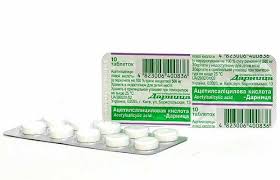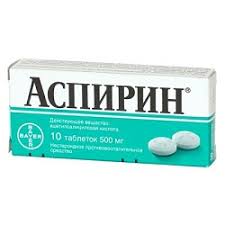Acetylsalicylic acid is the main NSAID in the salicylate class. The name aspirin was born as a trademark invented by Bayer , which first produced the drug, but over time it became the generic name for the substance.
Aspirin is the only irreversible inhibitor of cyclooxygenase, this property makes this substance, when taken in a chronic mode, able to reduce the long-term formation of thromboxane in platelets, thereby reducing the clotting properties of blood and making it more fluid. Therefore, acetylsalicylic acid is prescribed in low doses (cardioaspirin 100 mg) to reduce the risk of heart attacks and in high doses after an acute heart attack. Some studies have shown that using low-dose aspirin for several years (75 mg) also reduces the appearance of some forms of tumors.

The most undesirable side effects, especially at high dosages for oral administration on an empty stomach, are in the gastrointestinal tract, where ulcers and bleeding can occur. The mechanism of action includes a decrease in the synthesis of substances that protect the gastric mucosa. To reduce these effects, compounds of a basic or buffering nature are often added, as well as concomitant drugs with gastroprotective action and / or inhibitors of the cell hydrion pump or similar inhibitors of salt secretion. Another undesirable side effect, due to its anticoagulant properties, is an increase in blood loss in women during menstruation and the risk of critical postoperative hemorrhage.
Aspirin is taken by athletes in the caffeine association as an ergogen before endurance competition. This particular association determines the synergistic and thermogenic ergogenic effect, as it makes the body more metabolically active, releasing more energy substrates for physical activity. The commonly used doses are 200/400 mg dicafine, 250/500 mg aspirin.
Another benefit that aspirin provides for athletes is blood thinning and improving energy output by reducing platelet aggregation. Prolonged physical activity tends to increase blood viscosity, decreasing the athlete’s ability to oxygenate muscles. Acetylsalicylic acid, taken before a performance, prevents this effect and, as a result, also increases the elasticity of the muscle tissue due to the effect of greater blood perfusion. These effects allow the athlete to better handle endurance stress and also reduce the risk of possible injury from stiff muscles.
Aspirin is generally not used as a pain reliever, as its analgesic effect is weak compared to other drugs, so stronger NSAIDs are preferred for pain relief in the event of injury.
Salicylate intoxication can cause hyperventilation, palpitations, nausea, vomiting, sweating, thirst and confusion, up to convulsions, coma and death from respiratory failure in case of severe intoxication. In addition, aspirin use increases the risk of bleeding, bleeding and nosebleeds.
Ibuprofen
Ibuprofen is a moderately active NSAID also found in many over-the-counter products such as Moment, Buscofen, and Brufen. This active ingredient is used to treat mild to moderate pain and is well tolerated in the stomach. This substance belongs to the class of arylpropionics. It is rapidly absorbed orally and is active for about 2/4 hours. In low dosages (200/400 mg) it is anti-inflammatory and not used as an analgesic, in higher dosages it is used to treat rheumatoid arthritis, osteoarthritis and periarthritis.

Some athletes take ibuprofen (usually at a 400 mg dose) before competition to reduce fatigue in endurance tests. In particular, long-distance endurance athletes (marathons, triathlons, etc.) use this substance to gain weight at the end of the test. These athletes feel muscle soreness due to prolonged effort in the final stages of the competition, so they use ibuprofen to alleviate these troubles, this allows them to better support the final stages of the test. However, this practice leads to the benefit of the onset of injuries or to the accentuation of pre-existing injuries, since the reduced perception of pain caused by ibuprofen leads the athlete to intensify efforts, increasing the overload of the musculoskeletal system and, therefore, the risk of an accident. In fact, some studies (Donnelv) conducted on the use of this substance prior to resistance tests show that athletes who use it have higher blood levels of muscle damage markers. (C-reactive protein, CPK, cytokines, etc.). In addition, these subjects, taking ibuprofen even after exercise, do not offer much benefit in terms of post-test recovery. Therefore, according to these studies, the use of ibuprofen before and after an endurance test does not provide much benefit and increases muscle fatigue. It should be added that using ibuprofen after intense activity can reduce muscle pain caused by training, but you will not speed up recovery time, so in the case of close-range races it helps to experience less fatigue, but does not speed up recovery.
As a moderately active anti-inflammatory agent, ibuprofen is not even particularly effective in treating injuries for which other NSAIDs such as diclofenac, piroxicam, sulfindac, and nimesulide are more effective.
